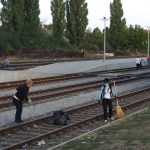An overview of the latest developments.
The refugee crisis in Croatia is continuing. Since the beginning of the crisis until yesterday at 1 pm, around 21,000 migrants have entered Croatia, but many of them have already left the country, reports Index.hr and Vecernji List on September 20, 2015.
Almost 2,000 people have spent the night in the open in Tovarnik, despite the rain. People lie on the ground and wait for the arrival of busses. The buses were coming through the night until 3 am, and about 30 buses with 1,500 people went to Hungary, but new refugees from Serbia have arrived in the meantime.
HRT reports that a group of migrants from Tovarnik arrived to the border train station Botovo by train last night at 2 am. Despite the rain, the migrants headed on foot towards an illegal crossing to Hungary. In two days and two nights, about 5000 people passed through the station.
On Saturday, Hungary accused Croatia of “lying to the European Union” by arguing that it has signed a bilateral agreement on the transfer of thousands of migrants to the Hungarian border. Hungarian foreign minister Peter Szijjarto has also accused Croatia that it “violated Hungarian sovereignty” by sending migrants across the border in train accompanied by Croatian police. “Instead of honest care for refugees, they were immediately sent to Hungary. What kind of European solidarity is that”, said the minister, adding that Hungary will accelerate the construction of a fence along the border with Croatia “where necessary”. “Hungary is once again in a difficult situation”, he said. “We will defend the European Union, the borders of the Schengen Zone and Hungary in accordance with the European rules.”
Chief of staff of the Hungarian prime minister Viktor Orban said that Hungary could block Croatian accession to the Schengen Zone if it fails to defend the external borders of the EU. “If Croatia lifts its hands and says, ‘No, we do not want to defend the borders’, then Hungary could say that it was not ready to join Schengen when the moment of decision-making comes”, said Rogan.
During the night, the reception centres in Slovenia received about 960 refugees. In the last few days, Slovenia has received more than 2,000 refugees in total. The Interior Ministry expects that the influx of migrants will decrease, and it is expected that those who are currently housed in centres in Slovenia will continue to the Austrian border. Most of the refugees are from Syria, followed by Afghans and Iraqis. For more than 90 percent of them, the final goal is Germany or the Scandinavian countries.
Slovenian prime minister Miro Cerar said on Saturday during a tour of Brežice and Novo Mesto that all migrants in Slovenia are being identified and registered in accordance with the European rules, and that Slovenia still acts as a guardian of the Schengen border, according to the Dublin Regulation on Asylum.
Slovenian Foreign Minister Karl Erjavec said on Saturday night for the Slovenian television that Slovenia can “temporarily” receive a maximum of about 9,000 refugees and migrants. With regard to finding a permanent solution, it is in constant contact with Austria and Germany. He said that they can expect a new wave of migrants and that therefore it is necessary for a common solution for the situation to be found at the EU level.
According to police data, Austria yesterday received about 10,000 people, while according to the local Red Cross, the number is even higher. The head of the Austrian Red Cross Gerry Foitik told APU news agency that between 12,000 and 13,000 migrants arrived to Austria from Slovenia and Hungary on Saturday. The deputy police chief in the Austrian province of Burgenland Christian Stella said that Hungary did not give them a warning about the new wave of refugees.









